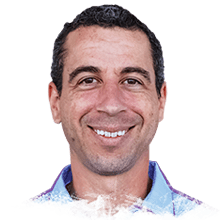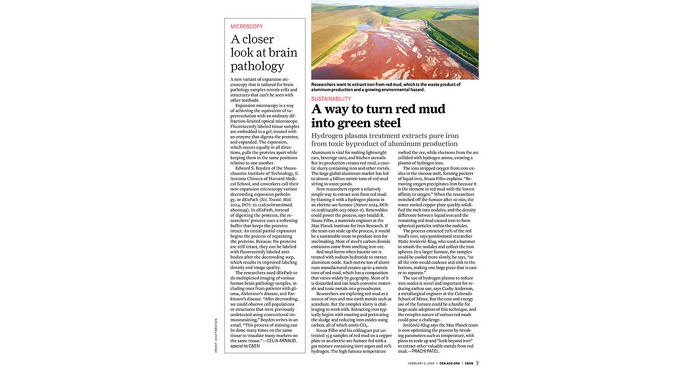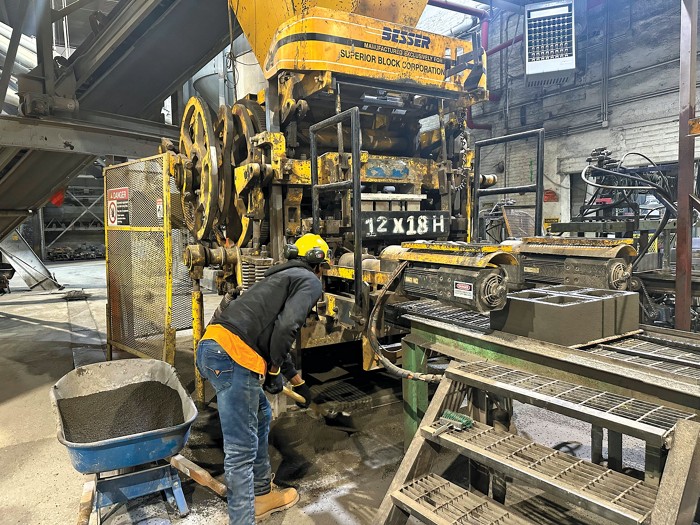Advertisement
Grab your lab coat. Let's get started
Welcome!
Welcome!
Create an account below to get 6 C&EN articles per month, receive newsletters and more - all free.
It seems this is your first time logging in online. Please enter the following information to continue.
As an ACS member you automatically get access to this site. All we need is few more details to create your reading experience.
Not you? Sign in with a different account.
Not you? Sign in with a different account.
ERROR 1
ERROR 1
ERROR 2
ERROR 2
ERROR 2
ERROR 2
ERROR 2
Password and Confirm password must match.
If you have an ACS member number, please enter it here so we can link this account to your membership. (optional)
ERROR 2
ACS values your privacy. By submitting your information, you are gaining access to C&EN and subscribing to our weekly newsletter. We use the information you provide to make your reading experience better, and we will never sell your data to third party members.
Sustainability
Raúl Hernández Sánchez
This supramolecular chemist uses molecular assemblies to purify water and develop clean energy catalysts
by Mark Peplow, special to C&EN
May 19, 2023
| A version of this story appeared in
Volume 101, Issue 16

Credit: Alejandra Bueno/Will Ludwig/C&EN | Raúl Hernández Sánchez
s a young boy growing up in Chihuahua, Mexico, Raúl Hernández Sánchez was a fan of the iconic wrestler El Santo. In dozens of movies, the masked luchador battled multifarious foes, including evil scientists whose secret laboratories were filled with bizarre equipment and fuming beakers. Those scenes captured the boy’s imagination: “I was 8 years old, thinking, ‘I would like to be working there!’ ” he says with a laugh.
Fortunately for us, the lab he now leads at Rice University is focused not on world domination but world preservation. “I’m trying to use supramolecular systems to tackle sustainability problems,” Hernández Sánchez says. His molecular assemblies are already showing promise in purifying water and helping generate hydrogen.
Advertisement
Hernández Sánchez began studying chemistry at the Monterrey Institute of Technology and Higher Education. But it was a summer internship at the California Institute of Technology, where he worked on a proton-conducting material used in fuel cells, that really fired his enthusiasm for research. His internship supervisor Sossina M. Haile, now at Northwestern University, remembers that he was “incredibly hard working. Whenever he had any obstacle, he was determined to overcome it.”
“That internship changed my life,” Hernández Sánchez recalls. “From there onwards, I knew that academia was for me.”
After a PhD on iron-cluster complexes with Theodore Betley at Harvard University, he moved to Columbia University for postdoctoral work with electrochemist Colin Nuckolls. “He was extraordinary, off the scale,” Nuckolls says, praising Hernández Sánchez’s versatility as a scientist. “He worked on three or four projects simultaneously, all of which resulted in high-quality papers.” One collaboration even led to a spin-off company, XL Batteries, which is developing flow batteries that use inexpensive organic molecules to store energy.
“I was 8 years old, thinking, ‘I would like to be working there!’ ”
—Raúl Hernández Sánchez, professor, Rice University
In 2018, Hernández Sánchez established his own group at the University of Pittsburgh (Pitt) and decided to make his mark in a fresh area of chemistry. “This is the part that’s truly extraordinary about him: he took his program in a completely different direction,” Nuckolls says. At Rice since 2022, Hernández Sánchez currently uses bowl-shaped macrocyclic molecules called resorcinarenes in a remarkable variety of ways.
For starters, he’s applying them as structural platforms to grow highly strained, aromatic carbon-based nanotubes called tubularenes. Conventional carbon nanotubes can act as molecular-scale computing components or electrochemical catalysts. But the standard production method, chemical vapor deposition, tends to produce mixtures of different structures. For applications that need carbon nanotubes with specific and reproducible electronic properties, that’s a problem.
Hernández Sánchez instead constructs his nanotubes with the precision of organic chemistry, ensuring that every tube in a batch is identical. He builds up the walls of the resorcinarene bowl to create a tailored tube with fine-tuned optical or electrochemical properties. His group is now testing the resulting tubularenes as hydrogen evolution catalysts in an electrochemical cell.
He’s also using resorcinarenes as supportive ligands for catalytic metal clusters, including a square of four copper atoms that mimics an active site in nitrous oxide reductase. Re-creating enzymatic reaction sites in this way could help chemists enhance the clusters’ catalytic activity. Hernández Sánchez hopes to eventually construct resorcinarene-supported metal clusters that convert carbon dioxide into useful products.
A third project uses fluorinated resorcinarenes to capture large anions. Hernández Sánchez has already incorporated these fluorocages into membranes that remove toxic per- and polyfluoroalkyl substances (PFAS) from water. “We have unpublished results where we can filter water and take environmentally relevant concentrations of about 1 ppb down to single-digit parts per trillion,” he says.
Aside from an intense research program, Hernández Sánchez is involved in a range of outreach activities aimed at improving diversity and inclusion in science. At Pitt, he established a chapter of the Alliance for Diversity in Science and Engineering (ADSE), a group that supports people who are underrepresented in science and engineering—including women; Black, Indigenous, and Latino people; people with disabilities; and LGBTQ+ people—and encourages them to pursue those careers. “That organization is still flourishing and growing; he left a huge impact there,” says Osvaldo Gutierrez, an associate professor at Texas A&M University, president of the ADSE, and a Talented 12 alumnus.
At Pitt, Hernández Sánchez also founded the program Tips for Students, in which recent graduates offer career guidance to undergraduates. And back in Chihuahua, he is a coordinator for Science Clubs Mexico, which runs free summer workshops for high school students. “He tackles outreach the same way he tackles his research: in multiple different areas,” Gutierrez says.
Vitals
Current affiliation:
Rice University
Age: 35
PhD alma mater:
Harvard University
Hometown:
Chihuahua, Mexico
When I’m not doing chemistry, I enjoy:
“Cooking. I am the chef at home. My wife and baby daughter love my food. When my baby licks her fingers and bib, I know I did a good job.”
My role model is:
“Rafael Nadal. I think he embodies how discipline and hard work guide you to success.”
Learn more/nominate a rising early-career chemist to be one of C&EN's Talented 12 at:
cenm.ag/t12-nominations-2024
As a young boy growing up in Chihuahua, Mexico, Raúl Hernández Sánchez was a fan of the iconic wrestler El Santo. In dozens of movies, the masked luchador battled multifarious foes, including evil scientists whose secret laboratories were filled with bizarre equipment and fuming beakers. Those scenes captured the boy’s imagination: “I was 8 years old, thinking, ‘I would like to be working there!’ ” he says with a laugh.
Vitals
▸ Current affiliation: Rice University
▸ Age: 35
▸ PhD alma mater: Harvard University
▸ Hometown: Chihuahua, Mexico
▸ When I’m not doing chemistry, I enjoy: “Cooking. I am the chef at home. My wife and baby daughter love my food. When my baby licks her fingers and bib, I know I did a good job.”
▸ My role model is: “Rafael Nadal. I think he embodies how discipline and hard work guide you to success.”
Fortunately for us, the lab he now leads at Rice University is focused not on world domination but world preservation. “I’m trying to use supramolecular systems to tackle sustainability problems,” Hernández Sánchez says. His molecular assemblies are already showing promise in purifying water and helping generate hydrogen.
Hernández Sánchez began studying chemistry at the Monterrey Institute of Technology and Higher Education. But it was a summer internship at the California Institute of Technology, where he worked on a proton-conducting material used in fuel cells, that really fired his enthusiasm for research. His internship supervisor Sossina M. Haile, now at Northwestern University, remembers that he was “incredibly hard working. Whenever he had any obstacle, he was determined to overcome it.”
“That internship changed my life,” Hernández Sánchez recalls. “From there onwards, I knew that academia was for me.”
After a PhD on iron-cluster complexes with Theodore Betley at Harvard University, he moved to Columbia University for postdoctoral work with electrochemist Colin Nuckolls. “He was extraordinary, off the scale,” Nuckolls says, praising Hernández Sánchez’s versatility as a scientist. “He worked on three or four projects simultaneously, all of which resulted in high-quality papers.” One collaboration even led to a spin-off company, XL Batteries, which is developing flow batteries that use inexpensive organic molecules to store energy.
In 2018, Hernández Sánchez established his own group at the University of Pittsburgh (Pitt) and decided to make his mark in a fresh area of chemistry. “This is the part that’s truly extraordinary about him: he took his program in a completely different direction,” Nuckolls says. At Rice since 2022, Hernández Sánchez currently uses bowl-shaped macrocyclic molecules called resorcinarenes in a remarkable variety of ways.
For starters, he’s applying them as structural platforms to grow highly strained, aromatic carbon-based nanotubes called tubularenes. Conventional carbon nanotubes can act as molecular-scale computing components or electrochemical catalysts. But the standard production method, chemical vapor deposition, tends to produce mixtures of different structures. For applications that need carbon nanotubes with specific and reproducible electronic properties, that’s a problem.
Hernández Sánchez instead constructs his nanotubes with the precision of organic chemistry, ensuring that every tube in a batch is identical. He builds up the walls of the resorcinarene bowl to create a tailored tube with fine-tuned optical or electrochemical properties. His group is now testing the resulting tubularenes as hydrogen evolution catalysts in an electrochemical cell.
He’s also using resorcinarenes as supportive ligands for catalytic metal clusters, including a square of four copper atoms that mimics an active site in nitrous oxide reductase. Re-creating enzymatic reaction sites in this way could help chemists enhance the clusters’ catalytic activity. Hernández Sánchez hopes to eventually construct resorcinarene-supported metal clusters that convert carbon dioxide into useful products.
A third project uses fluorinated resorcinarenes to capture large anions. Hernández Sánchez has already incorporated these fluorocages into membranes that remove toxic per- and polyfluoroalkyl substances (PFAS) from water. “We have unpublished results where we can filter water and take environmentally relevant concentrations of about 1 ppb down to single-digit parts per trillion,” he says.
Aside from an intense research program, Hernández Sánchez is involved in a range of outreach activities aimed at improving diversity and inclusion in science. At Pitt, he established a chapter of the Alliance for Diversity in Science and Engineering (ADSE), a group that supports people who are underrepresented in science and engineering—including women; Black, Indigenous, and Latino people; people with disabilities; and LGBTQ+ people—and encourages them to pursue those careers. “That organization is still flourishing and growing; he left a huge impact there,” says Osvaldo Gutierrez, an associate professor at Texas A&M University, president of the ADSE, and a Talented 12 alumnus.
At Pitt, Hernández Sánchez also founded the program Tips for Students, in which recent graduates offer career guidance to undergraduates. And back in Chihuahua, he is a coordinator for Science Clubs Mexico, which runs free summer workshops for high school students. “He tackles outreach the same way he tackles his research: in multiple different areas,” Gutierrez says.



















Join the conversation
Contact the reporter
Submit a Letter to the Editor for publication
Engage with us on Twitter